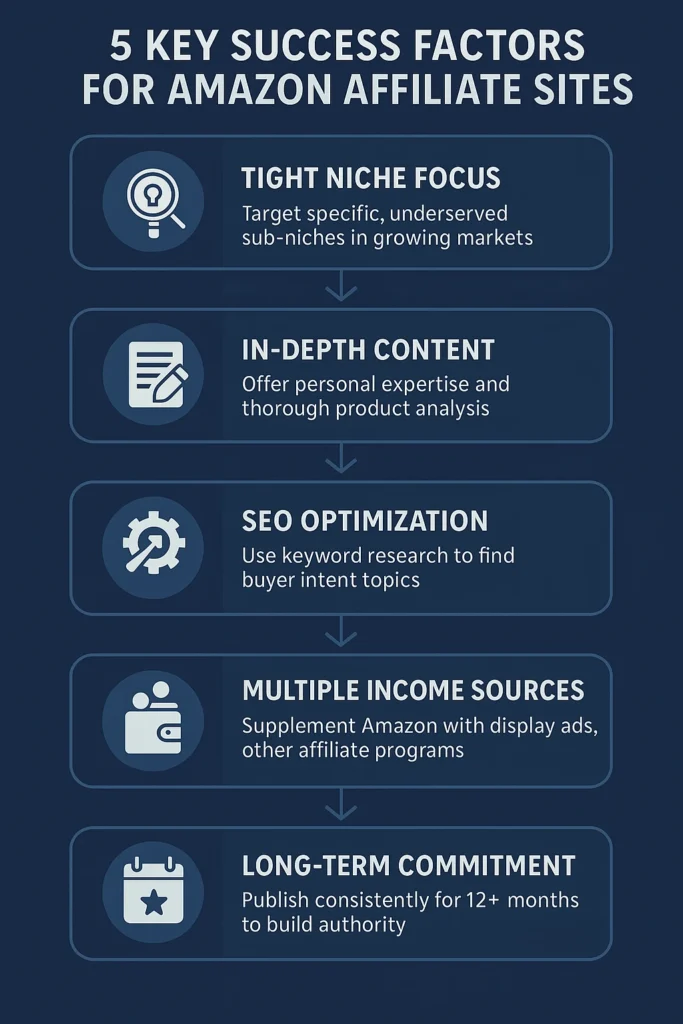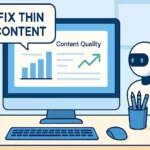Success Stories: 5 Real Case Studies of Amazon Affiliate Niche Sites

Introduction
Looking for real-life Amazon affiliate niche site case studies that show exactly how bloggers build profitable websites? In this article, you’ll discover five detailed examples of people who turned simple niche sites into reliable income streams using the Amazon Associates program.
In this article, I’ve compiled five authentic Amazon affiliate niche site case studies of individuals who have successfully built profitable niche websites. These stories reveal their unique approaches, tools, mistakes, and ultimately, their paths to generating substantial passive income. Whether you’re just starting your affiliate marketing journey or looking to improve your existing sites, these real-world examples provide valuable insights you can apply to your own business.

Amazon Affiliate Case Study #1: Sarah’s Home Office Equipment Site
The Niche Selection Process
Sarah, a former corporate manager, launched her home office equipment review site in late 2020 when remote work became widespread. Rather than targeting all office supplies, she specifically focused on ergonomic equipment for home offices – a niche that was expanding rapidly but hadn’t yet become oversaturated.
“I noticed that people were setting up home offices but didn’t know which ergonomic equipment was worth investing in,” Sarah explains. “Many were experiencing back pain and wanted expert recommendations.”
Strategy & Content Approach
Sarah’s content strategy focused on three main pillars:
- In-depth product reviews: She personally tested ergonomic chairs, standing desks, keyboard trays, and monitor arms before writing detailed reviews.
- Comparison articles: She created “Best X for Y” posts (like “Best Standing Desks for Small Spaces”) that compared 5-7 products.
- Problem-solution content: Articles addressing specific pain points like “How to Set Up an Ergonomic Workspace in a Studio Apartment.”
Rather than publishing daily content, Sarah prioritized quality over quantity, releasing just 2-3 comprehensive articles weekly. Each post averaged 2,500-3,000 words and included original photos of her using the products.
Tools Used
Sarah relied on several key tools to build and optimize her site:
- WordPress with Astra Theme
- RankMath for SEO optimization
- Ahrefs for keyword research
- Canva for creating graphics
- AAWP Plugin for Amazon product boxes
Income Progression
Sarah’s income growth followed an interesting pattern:
| Month | Articles Published | Monthly Amazon Earnings |
|---|---|---|
| 1–3 | 25 | $75–150 |
| 4–6 | 48 | $350–750 |
| 7–9 | 65 | $1,200–1,800 |
| 10–12 | 78 | $2,500–3,200 |
| 18 | 95 | $5,500+ |
By month 24, her site was consistently generating $7,000-8,000 monthly in Amazon affiliate commissions, and she had added display ads through Mediavine, bringing in an additional $2,500-3,000 per month.
Mistakes & Lessons
Sarah admits she made several mistakes along the way:
“My biggest mistake was initially focusing on low-priced products. When I shifted to reviewing premium ergonomic chairs and standing desks in the $300-1,200 range, my commission rates dramatically improved even with the same traffic.”
Like many of the amazon affiliate case studies featured here, Sarah learned that targeting low-competition long-tail keywords often brings better early results than chasing broad search terms.
Key Takeaway
What readers can learn: Niche selection timing is crucial – Sarah entered the home office equipment space just as demand was surging. Additionally, her personal testing of products built credibility that generic review sites couldn’t match.
For more on choosing the right niche, read our Step-by-Step Amazon Affiliate Niche Site Blueprint.
Amazon Affiliate Case Study #2: Mark’s Outdoor Survival Gear Site
Finding an Underserved Audience
Mark, an avid outdoorsman, built a niche site focused on survival gear and emergency preparedness equipment. His background as a wilderness guide gave him credibility, but his site’s success came from identifying an underserved segment: urban professionals interested in emergency preparedness who lacked outdoor experience.
Strategy & Content Approach
Mark’s content strategy differed from typical review sites:
- Scenario-based content: Articles like “Essential Gear for 72-Hour Power Outages” or “Best Equipment for Car Emergency Kits”
- Educational content first: 60% of his content taught readers skills, while 40% recommended products
- Video demonstrations: He created YouTube videos showing how to use equipment, embedding them in his articles
Mark focused heavily on building an email list, offering a free “Urban Survival Checklist” that converted at 4.7%. His email sequence gradually introduced affiliate products while providing valuable information.
Tools Used
Mark’s toolkit included:
- WordPress with GeneratePress Theme
- Semrush for competitor analysis
- Convertkit for email marketing
- Thrive Leads for opt-in forms
- Lasso for affiliate link management
Income Path
Mark’s revenue growth was slower initially but became more diversified:
| Revenue Source | Month 6 | Month 12 | Month 18 | Month 24 |
|---|---|---|---|---|
| Amazon Affiliates | $320 | $1,450 | $3,200 | $4,800 |
| Other Affiliate Programs | $0 | $750 | $2,100 | $3,900 |
| Digital Survival Guide | $0 | $0 | $900 | $1,800 |
| Total Monthly Income | $320 | $2,200 | $6,200 | $10,500 |
A significant insight from Mark’s case was his strategic diversification beyond Amazon — one of several smart moves found throughout these Amazon affiliate niche site case studies. By month 24, Amazon represented less than 50% of his total income.
Discover more options in our list of the Best Affiliate Programs for Beginners in 2025.
Mistakes & Challenges
“My biggest mistake was being too product-focused initially,” Mark admits. “Once I shifted to solving specific problems and scenarios, reader engagement skyrocketed.”
He also initially neglected mobile optimization, despite 70% of his audience accessing the site via smartphones.
Key Takeaway
What readers can learn: Mark’s success demonstrates that building authority content before heavy monetization creates stronger long-term results. Additionally, diversifying beyond Amazon protected his income when Amazon reduced commission rates in 2020.
Amazon Affiliate Case Study #3: Elena’s Kitchen Gadget Testing Blog
Niche Selection: Passion + Expertise
Elena, a former restaurant sous chef, combined her culinary expertise with her interest in kitchen technology to create a niche site focused on testing and reviewing kitchen gadgets and small appliances.
Her approach stood out because she demonstrated actual cooking techniques with each device, rather than simply listing features.
Content Strategy
Elena developed a comprehensive content approach:
- Definitive guides: In-depth articles on specific appliance categories (e.g., “The Complete Guide to Air Fryers”)
- Practical testing videos: She showed actual cooking results with each device
- Recipe adaptations: Content showing how to modify recipes for specific appliances
- Problem-solving articles: Posts like “How to Fix Common Air Fryer Problems”
Elena published consistently twice weekly but focused on seasonal trends, ramping up content about grilling equipment before summer and baking gadgets before holiday seasons.
Tools Used
Elena’s technical stack included:
- WordPress with WooCommerce (she later added a small shop)
- Yoast SEO Premium
- KeySearch for keyword research
- Tasty Links for affiliate link management
- Social Snap for social sharing
Revenue Development
Elena’s income growth shows the power of seasonality in this niche:
| Period | Monthly Amazon Revenue | Other Revenue | Total Monthly Revenue |
|---|---|---|---|
| Months 1–6 | $200–450 | $0 | $200–450 |
| Months 7–12 | $800–1,500 | $200–300 (display ads) | $1,000–1,800 |
| Holiday Season (Year 1) | $3,200 | $500 (display ads) | $3,700 |
| Year 2 Average | $2,800 | $1,200 (ads + brand deals) | $4,000 |
| Holiday Season (Year 2) | $7,500 | $2,000 (ads + brand deals) | $9,500 |
The notable aspect of Elena’s revenue is the dramatic seasonal spikes – November and December generated nearly triple her average monthly income.
Challenges & Solutions
Elena faced several challenges:
“Managing inventory for testing was expensive and required space. I started by borrowing appliances from friends before reinvesting profits into purchasing review units.”
She also struggled with return periods for Amazon products she tested. Her solution was developing relationships with local retailers and eventually with manufacturers directly, who began sending free products for review.
Key Takeaway
What readers can learn: Elena’s case demonstrates the power of authentic expertise in a product-focused niche. While many kitchen gadget sites simply rewrite manufacturer specifications, her actual cooking demonstrations and professional insights created genuine authority that readers trusted.
Amazon Affiliate Case Study #4: Tom’s Budget Gaming PC Niche Site
Niche Within a Niche
Tom, a college student and gaming enthusiast, created a site targeting a highly specific segment: budget-conscious PC gamers looking to build affordable gaming setups.
Rather than competing with major tech sites reviewing high-end equipment, he focused exclusively on components and peripherals under $100, helping gamers maximize performance on tight budgets.
Strategy Approach
Tom’s content strategy targeted specific pain points:
- Budget build guides: Complete PC builds at specific price points ($500, $700, $900)
- Component showdowns: Comparing similarly priced items (e.g., “Best GPUs Under $250”)
- Upgrade path content: Articles like “5 Most Impactful Upgrades Under $100”
- Deal alerts: Time-sensitive posts about substantial price drops on Amazon
His key differentiator was performance testing. Tom actually built the systems he recommended and ran benchmark tests, showing real-world performance data rather than just specifications.
Tools Used
Tom operated with a minimal toolkit:
- WordPress with Kadence Theme
- Ubersuggest for keyword research (cheaper than premium tools)
- Amazon OneLink for international monetization
- TablePress for creating comparison tables
- Google Analytics for traffic analysis
Income Development
Tom’s income growth followed an interesting pattern:
| Timeframe | Monthly Amazon Commissions | Monthly Display Ad Revenue | Total Monthly Income |
|---|---|---|---|
| Months 1–3 | $50–120 | $0 | $50–120 |
| Months 4–6 | $280–450 | $80–150 | $360–600 |
| Months 7–12 | $900–1,400 | $300–500 | $1,200–1,900 |
| Year 2 Average | $2,800–3,500 | $800–1,000 | $3,600–4,500 |
What’s interesting about Tom’s case is how he leveraged seasonal events like Black Friday, Amazon Prime Day, and back-to-school periods, with his revenue often doubling during these promotional periods.
Mistakes & Course Corrections
“My biggest mistake was initially ignoring international visitors,” Tom explains. “Once I implemented Amazon OneLink to serve UK, Canadian, and German visitors with their local Amazon stores, my revenue increased by 35% almost overnight.”
Tom also initially focused on too many different component categories. When he narrowed his focus to GPUs, CPUs, and monitors – the components with the highest price points – his commission rates improved substantially.
Key Takeaway
What readers can learn: Tom’s success came from addressing a specific audience pain point (gaming on a budget) and providing concrete evidence through actual testing. His case also demonstrates that even students with limited resources can build profitable affiliate sites by leveraging specific expertise.
Amazon Affiliate Case Study #5: Lisa’s Baby Product Review Blog
From Personal Need to Professional Site
Lisa’s journey began when she became a mother and discovered the overwhelming world of baby products. Her site started as a personal blog documenting her experiences with different products but evolved into a comprehensive review site for baby gear.
Content Approach
Lisa developed a multi-faceted content strategy:
- Age-based recommendations: Content organized by developmental stages (newborn, 3-6 months, etc.)
- Problem-solving content: Articles addressing specific challenges like “Best Products for Babies Who Hate Car Seats”
- Comparative reviews: In-depth comparisons of similar products across price points
- Safety-focused content: Articles highlighting product recalls and safety concerns
A key differentiator was Lisa’s “real life” testing – she photographed products being used in actual home environments rather than studio settings, giving readers a better sense of size, functionality, and practicality.
Tools Used
Lisa’s technical infrastructure included:
- WordPress with Divi Theme
- SEMrush for keyword research
- Tailwind for Pinterest marketing (a major traffic source)
- OptinMonster for email capture
- Link Whisper for internal linking
Income Evolution
Lisa’s revenue growth demonstrates the value of diversification:
| Revenue Stream | Year 1 (Monthly Avg) | Year 2 (Monthly Avg) | Year 3 (Monthly Avg) |
|---|---|---|---|
| Amazon Associates | $600 | $2,500 | $4,200 |
| Other Affiliate Programs | $200 | $1,800 | $3,900 |
| Display Advertising | $150 | $900 | $2,100 |
| Sponsored Content | $0 | $500 | $1,500 |
| Digital Baby Planner | $0 | $300 | $1,200 |
| Total Monthly Income | $950 | $6,000 | $12,900 |
What stands out in Lisa’s case is her strategic diversification into higher-commission affiliate programs. While Amazon offered convenience, she discovered that baby product manufacturers often had their own affiliate programs with commission rates of 10-15% versus Amazon’s 3%.
Challenges & Adaptations
“My biggest challenge was keeping content updated,” Lisa explains. “Baby products change constantly, with new models and discontinuations happening frequently.”
Her solution was creating a systematic review update calendar and hiring a part-time virtual assistant to help monitor product availability and specification changes.
Another challenge was seasonal fluctuation – baby product purchases peaked around baby showers (spring) and Black Friday. Lisa adapted by creating gift guides and deal content to maximize these peak periods.
Key Takeaway
What readers can learn: Lisa’s case demonstrates the value of transforming personal experience into expert content. Her authentic voice and hands-on product demonstrations built stronger reader trust than sites simply aggregating manufacturer information. Additionally, her willingness to explore beyond Amazon for monetization significantly increased her income potential.
Learn more in The Ultimate Guide to Monetizing Your Email List and Digital Product Creation: From Concept to Cash in 30 Days
Expert Insights from Top Amazon Affiliate Case Studies
According to Pat Flynn, founder of Smart Passive Income, the most successful affiliate marketers share a common trait: “The most successful affiliate marketers don’t focus on the commission – they focus on solving real problems for their audience. When you help someone make a better purchasing decision, the commissions follow naturally.”
Doug Cunnington, niche site expert, emphasizes patience: “Most people give up right before their sites gain traction. The sites that succeed are usually the ones where the owner committed to at least 12 months of consistent content creation before expecting significant results.”
Spencer Haws, founder of Niche Pursuits, highlights the importance of content quality: “Low-quality review sites are dying out. The sites dominating Amazon affiliate marketing today have genuine expertise, actual product testing, and truly helpful content that rises above generic reviews.”
If you’re optimizing for deliverability and engagement, check out our guide on How to Increase Email Open Rates by 37%.
What These Amazon Affiliate Case Studies Have in Common
| Success Factor | Sarah (Office) | Mark (Survival) | Elena (Kitchen) | Tom (Gaming) | Lisa (Baby) |
|---|---|---|---|---|---|
| Primary Traffic Source | Organic Search | Email List + Search | Search + YouTube | Search + Forums | Pinterest + Search |
| Content Frequency | 2–3 posts weekly | 1–2 posts weekly | 2 posts weekly | 3–4 posts weekly | 2 posts weekly |
| Monetization Mix | 70% Amazon / 30% Ads | 45% Amazon / 55% Other | 65% Amazon / 35% Other | 75% Amazon / 25% Ads | 35% Amazon / 65% Other |
| Time to $1K/month | 6 months | 9 months | 7 months | 8 months | 10 months |
| Time to $5K/month | 16 months | 19 months | 20 months | 22 months | 18 months |
| Key Differentiator | Personal product testing | Real-world scenarios | Professional culinary expertise | Performance benchmarks | Real-life implementation |

Common Patterns Among Successful Amazon Affiliate Sites
Despite the different niches, several patterns emerged across all case studies:
- Genuine expertise or experience with the products being promoted
- Content that went beyond specifications to provide real-world usage insights
- Solving specific problems rather than creating generic “10 Best” lists
- Systematic keyword research focusing on buyer intent terms
- Strategic expansion beyond Amazon as the sites matured
- Consistent publishing schedules maintained for at least 12+ months
- Reinvestment of early profits into better content, tools, or actual products for testing
Want to dig deeper into how to optimize conversions on your Amazon site? Don’t miss our 15 Proven Amazon Affiliate CRO Strategies.
Frequently Asked Questions Based on These Amazon Affiliate Niche Site Case Studies
How long does it typically take for an Amazon affiliate site to become profitable?
Based on our case studies, most niche sites began seeing meaningful income ($500-1,000 monthly) between months 6-10. However, reaching full-time income levels ($5,000+ monthly) typically required 16-24 months of consistent effort. The key factors affecting timeline are niche competition, content quality, publishing consistency, and average price point of promoted products.
What’s more important for Amazon affiliate success: traffic volume or conversion rate?
While both matter, our case studies suggest conversion optimization ultimately delivers better results. Tom’s gaming site and Elena’s kitchen gadget site had similar traffic, but Elena earned nearly 40% more because she optimized for higher-priced items and better conversion rates. Focus first on attracting the right visitors with buying intent, then optimize your content to convert them effectively.
Should new affiliate marketers focus exclusively on Amazon or use multiple programs?
Start with Amazon for simplicity and convenience, but plan to diversify once you understand your audience’s buying habits. All five case studies showed significant income growth after expanding beyond Amazon. This diversification also protected income when Amazon adjusted commission rates downward. Most successful affiliates reach a point where Amazon represents 40-60% of their affiliate income rather than 100%.
How important is personal product testing for Amazon affiliate sites?
Extremely important, according to our case studies. Sites offering direct product interaction, original visuals, and honest evaluations consistently outperformed those merely echoing manufacturer specs. Although buying every item isn’t always realistic in the beginning, top affiliates found inventive ways to get products into their hands for authentic trials, including borrowing, rental services, and eventually brand partnerships.
Are Amazon affiliate sites still viable with lower commission rates?
Yes, but strategy adjustments are necessary. Today’s successful Amazon affiliates focus on higher-priced items, supplement with display advertising, negotiate direct affiliate relationships with brands, and create stronger content that converts at higher rates. While lower commission rates have challenged the model, all five case studies demonstrated continued growth by adapting their approaches rather than relying solely on Amazon’s program.
Conclusion
These five Amazon affiliate niche site case studies reveal that building a profitable niche site remains viable in 2025, but requires a strategic approach far beyond simply publishing product listings with affiliate links. The most successful sites blend credible know-how, firsthand product involvement, and content that genuinely supports smart buying decisions.
Whether you’re interested in kitchen gadgets, office equipment, baby products, gaming gear, or survival equipment, these amazon affiliate case studies prove that consistent strategy and audience understanding are key to success.
If you’re still figuring out your niche or blog idea, don’t miss my Complete Beginner’s Guide to Starting a Blog and Making Money in 2025 — it’s the perfect companion to this digital product roadmap.
Want more insights on building profitable affiliate sites and maximizing passive income? Join our Telegram channel “BloggingRevenue” for daily tips, strategies, and exclusive case studies from successful affiliate marketers.








